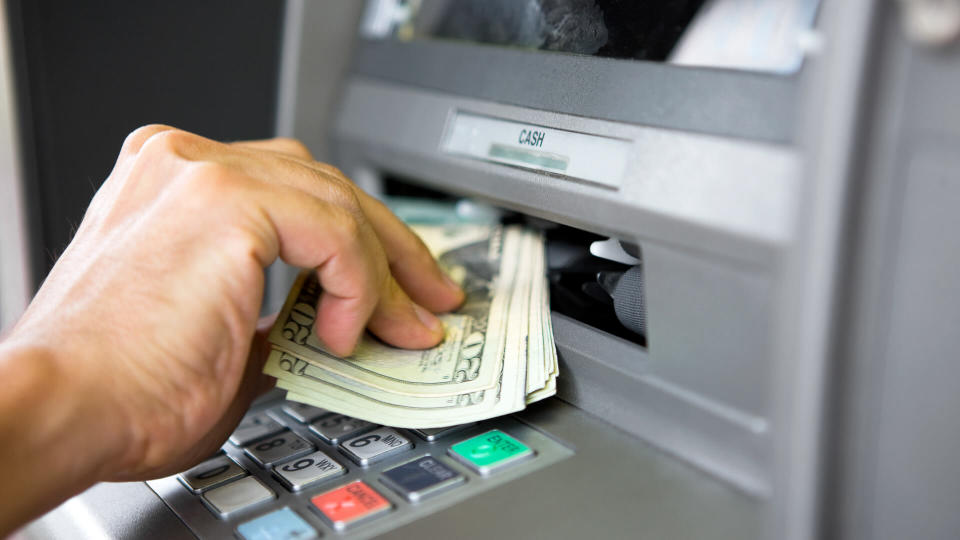7 Things To Know If You Withdraw More Than $10,000 From Your Checking Account

If you’ve taken the advice to save as much money as in an emergency fund or other form of savings, you should feel entitled to take out money when needed. That’s what it’s there for, after all.
Learn More: Warren Buffett: 6 Best Pieces of Money Advice for the Middle Class
Find Out: How To Get $340 Per Year in Cash Back on Gas and Other Things You Already Buy
However, taking out large sums of money isn’t as simple as just doing so. There are legal and other financial considerations to factor in even when it’s your own money.
Experts explain what you need to do before you take out $10,000 or more from your accounts.
Also, see the guidelines on high-yield accounts.
Sponsored: Owe the IRS $10K or more? Schedule a FREE consultation to see if you qualify for tax relief.
Understand Federal Reporting Requirements
“When withdrawing a substantial sum like $10,000 or more from your checking account, one of the primary concerns is the potential triggering of federal reporting requirements,” according to Abid Salahi, co-founder of FinlyWealth, a credit card recommendation platform.
“Financial institutions are legally obligated to file a currency transaction report (CTR) for cash transactions exceeding $10,000,” he explained. “This reporting mechanism aims to combat money laundering and other illicit activities.”
Chris Demetriou, a qualified accountant and co-founder of Archimedia Accounts, had to walk a manufacturing client who needed to withdraw a sizable portion of revenues for new equipment through this process recently.
Check Out: You Can Get These 3 Debts Canceled Forever
“Naturally, they were anxious about triggering reports and drawing scrutiny,” Demetriou said. “By walking through the ins and outs of regulations and best practices, I was able to assure them … that with proper planning, even six-figure transactions can be safely executed.
“While this may cause concern, the report itself usually leads nowhere — authorities are focused on true criminal cases, not average citizens. However, it’s still vital to avoid ‘structuring’ by breaking amounts into sub-$10,000 transactions. Not only does this conflict with the spirit of the law, it can raise suspicion unnecessarily.”
Expect Delays on Your Funds
Salahi said he has seen numerous instances where clients were caught off guard by this regulatory requirement and unable to get the funds on the day they wanted.
“After providing the necessary documentation and explaining the legitimate purpose of the withdrawal,” he said, “the transaction was eventually processed, but not without significant inconvenience and delay.”
Keep a Paper Trail
It’s crucial to have a clear paper trail and reasonable explanation for needs of this size, Demetriou said.
“Come tax or audit time, a trail of legitimate invoices, receipts or contracts demonstrates the money is going towards a real cost like a major home renovation,” he said. “Without cause, questions may arise. So keep paperwork tidy.”
Salahi added, “This transparency helps ensure compliance with anti-money laundering regulations and facilitates a smoother transaction process.”
Speak Directly to Your Bank
For peace of mind, Demetriou recommended speaking directly with banking professionals if you need to make a large withdrawal.
“Explain plans factually and address any worries they have up front,” he said. “Reputable banks don’t want illicit activity either, so establishing confidence and transparency early assists all parties.”
Salahi explained that most banks require at least 24 hours notice for withdrawals exceeding $10,000, allowing them to prepare the necessary cash reserves and complete the required paperwork.
Consider the Impact on Your Savings
Additionally, it’s important to consider the impact of withdrawing a big amount on your emergency fund, said David Rafalovsky, CEO of Oxygen, a comprehensive financial platform.
“A well-advised rule of thumb is to have enough savings to cover three to six months of living expenses,” he said. “Withdrawing a large amount could deplete this safety net, leaving you vulnerable in case of unexpected financial emergencies.”
Review Missed Opportunities
It’s also important to think about the potential for missed financial opportunities if you take out so much cash, Rafalovsky said.
“Funds in your checking account could be earning interest in a savings or investment account,” he said. “By withdrawing a large sum, you’re not just losing the principal amount but also the future growth it could have generated. This opportunity cost can significantly affect your long-term financial goals, such as retirement or purchasing a home.”
Avoid Bank Fees and Penalties
Furthermore, consider any potential fees or penalties associated with your withdrawal, Rafalovsky said.
“Some accounts have minimum balance requirements, and dropping below these thresholds can lead to monthly maintenance fees,” he said. “Additionally, if this withdrawal is intended for investment purposes, be mindful of timing and market conditions. A hasty decision could lead to entering the market at a less than optimal time, affecting the return on your investment.”
By taking these important steps in advance of a big withdrawal, you should have little trouble getting access to your own well-saved money.
More From GOBankingRates
This article originally appeared on GOBankingRates.com: 7 Things To Know If You Withdraw More Than $10,000 From Your Checking Account

 Yahoo Finance
Yahoo Finance 